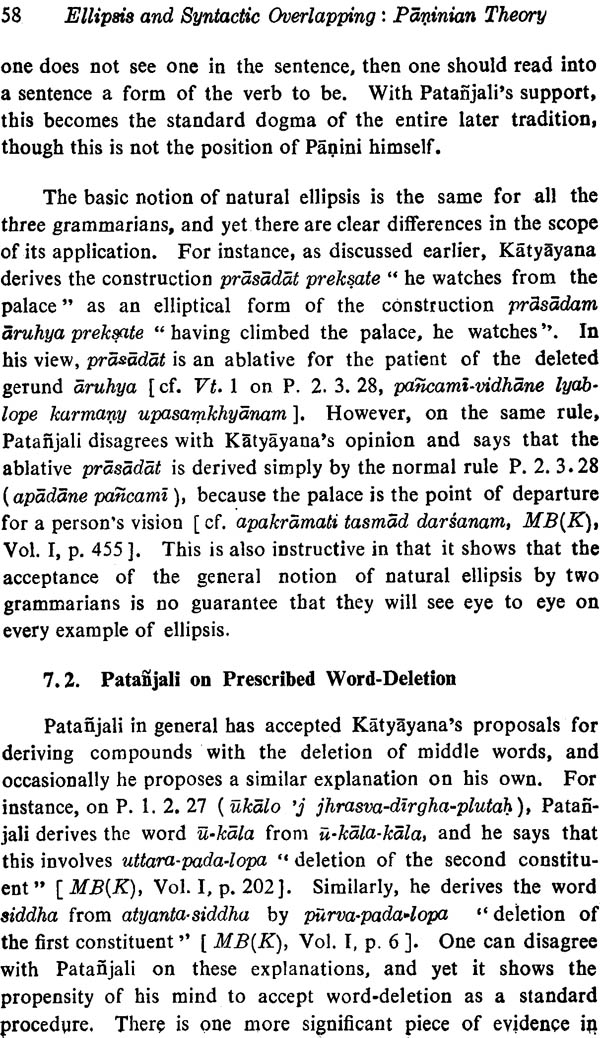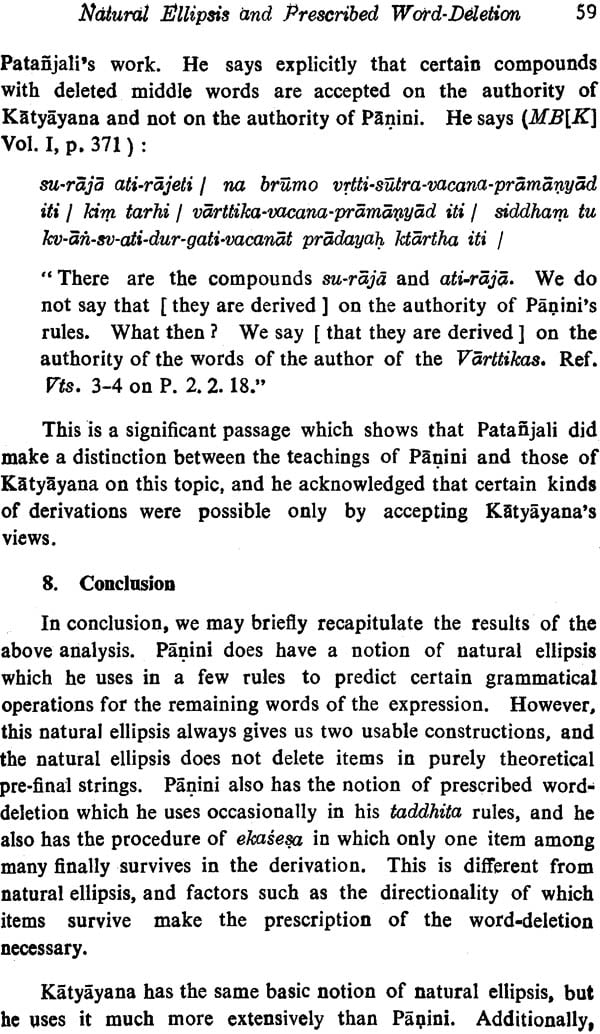
Ellipsis and Syntactic Overlapping: Current Issues in Paninian Syntactic Theory (An Old and Rare Book)
Book Specification
| Item Code: | NAJ822 |
| Author: | Madhav M. Deshpande |
| Publisher: | Bhandarkar Oriental Research Institute, Pune |
| Language: | English |
| Edition: | 1985 |
| Pages: | 106 |
| Cover: | Paperback |
| Other Details | 8.5 inch X 5.5 inch |
| Weight | 120 gm |
Book Description
Foreword
It was, indeed, a special pleasure for us to have had Professor Madhav M. Deshpande to deliver the “Pandit Shripad Shastri Deodhar Memorial Lectures” (second series). We claim Professor Deshpande to be essentially a Poona product. After a brilliant career at Poona, Deshpande went over to the Pennsyl- vania University, U. S. A., for further training. In course of time, he was appointed Professor of Sanskrit and Linguistics in the University of Michigan. We have watched his remarkable progress with great personal interest and have heartily rejoiced over it.
Professor Deshpande’s output during these few years has been rich and varied. One of his earlier writings dealt with the concept of dialect in. the Paninian grammatical, tradition. In another early paper, he undertook a historical investigation of the Paninian procedure of taparakaran,a. Among his other contributions to the Paninian studies may be mentioned his papers, “The scope of homogeneous representation in. Panini in which he discusses the Sivasutras, “Panini and the Vedic evidence” in which he points out that Panini has made a clear distinction between the use of the varieties of past tense in the early Sainhitas and their use in his own current Sanskrit which is very close to the, prose of the Brahmanas, and “Linguistic presuppositions of Panini 8. 3. 26-27 “ in which he has shown that, very much like the current pronunciation of Sanskrit, the pronunciation of Sanskrit in Panini’s days was influenced by the vernacular languages, e.g. Prakrits, and his monograph on Savarnya. Writing on Rk-Pratisakhya 13.5-6, Deshpande clarifies the distinction between the notions of nada (=glottal resonance) and qhoea (=oral resonance). Elsewhere he deals with the phonetics of v and short a. His interest in Sanskrit phonetics is further confirmed by his announcement regarding the proposed critical edition of the Saunakiya Caturadhyayika for which he has already collected H manuscripts.
Professor Deshpande’s contributions to sociolinguistics are particularly original. I still vividly remember his paper on the genesis of the Rgvedic retroflexion in which he has argued that, in the case of Sanskrit, the origin of retroflexion lies not so much in the Aryans’ borrowing this trait from the Dravidians in early times as in the Dravidians’ adopting Aryan speech to their native phonology. In this very context I may mention Deshpande’s two monographs; Sociolinguistic Attitudes in India: An Historical Reconstruction and Evolution of 8yntactic Theory in Sanskrit Grammar, and two papers, “Some aspects of prehistoric Indo-Aryan” and “History, change and permanence: a classical Indian perspective”.
But let me not go on in this bibliographical strain. For, all that] had wanted to do was to prepare, if possible, a suitable background for Deshpande’s lectures. Actually, however, Professor Deshpande hardly needs any introduction to an audience of students and teachers of Sanskrit.
Incidentally, I should like to refer to an interesting coincideuce. The first series of the “Pandit Shripad Shastri Deodhar Memorial Lectures” was delivered by Deshpande’s teacher Professor Cardona.
Preface
I wish to express my deep gratitude to Professor R. N. Dandekar and the Bhandarkar Oriental Research Institute for having invited me to deliver the “Pandit Shripad Shastri Deodhar Memorial Lectures” in June 1985. This gave me a valuable opportunity to present my recent researches in Paninian syntax before the learned audience of scholars in Poona. I hope that the publication of these lectures will lead to a further interest in exploring the unexplored treasures of the field of Paninian syntax and its interpretation and evaluation in relation to facts of Indian linguistic history on the one hand, and the evolving theories of modern linguistics on the other.
In the course of these lectures, occasionally I had to disagree with the conclusions of the previous work in this area by Professor Paul Kiparsky and Professor S.D. Joshi. Such inevitable disagreements in the course of an honest and free discussion of a difficult subject in no way reflect a lack of respect on my part for these scholars and their work. On the contrary, their work inspired me to undertake a re-examination of the concepts of ellipsis and syntactic overlapping in Panini, a task which could not have been carried out without the foundation laid by these and other scholars.
In developing ideas presented in these lectures, I was greatly assisted by the enthusiasm of my student Ms, Elena Bashir, with whom I had many long discussions and who read previous drafts of these lectures and made valuable suggestions. I am also indebted to Professor Peter E. Hook of the University of Michigan and Professor Richard Salomon of the University of Washington for their constructive criticism. I am also grateful for the suggestions made by various scholars in the audience at Poona. However, I must bear responsibility for the conclusions presented in these lectures. Last but not least, I must thank the College of Literature, Science and the Arts of the University of Michigan for providing funds which made it possible for me to travel to India to deliver these lectures.
Contents
|
| Foreword |
|
|
| Preface |
|
|
| Lecture One |
|
|
| Ellipsis and Syntactic Overlapping in Panini: A Review of Current Ideas | 1-32 |
| 1. | Introduction | 11 |
| 2. | Equi-NP-Deletion in Transformational Grammar | 2 |
| 3. | Kiparsky on Ellipsis in Panini | 3 |
| 4. | Ellipsis versus Syntactic Overlapping | 5 |
| 5. | S. D. Joshi on P. 3. 1. 87 | 7 |
| 6. | Critique of Joshi’s Position on P. 3. 1. 87 | 9 |
| 7. | S. D. Joshi on P. 1. 3. 67 | 16 |
| 8. | Critique of Joshi’s Position on P. 1. 3. 67 | 18 |
| 9. | S. D. Joshi on P. 1. 4. 52 | 21 |
| 10. | Critique of Joshi’s Position on P. 1. 4. 52 | 22 |
| 11. | On the Transformational Interpretation of Panini | 23 |
| 12. | Re-examining the Notion of Ellipsis in Panini | 26 |
| 13. | Ellipsis and Syntactic Overlapping: Complementary Principles in Panini | 28 |
| 14. | Ellipsis and Syntactic Overlapping: Complementary Principles in Katyayana | 30 |
|
| Lecture Two |
|
|
| Natural Ellipsis and Prescribed Word-Deletion in Sanskrit Grammar | 33-60 |
| 1. | Natural Ellipsis in Panini | 33 |
| 2. | Equivalent Non-Elliptical Constructions in Panini | 34 |
| 3. | Nature of Natural Ellipsis in Panini | 35 |
| 4. | Prescribed Word-Deletion in panini | 36 |
| 4.1. | The Ekasetp Procedure | 37 |
| 4.1.1. | Obligatory “One Constituent Retention” | 38 |
| 4.1.2. | Optional ,c One Constituent Retention” | 39 |
| 4.2. | Prescribed, Word-Deletion in the Taddhita Section | 39 |
| 4.2.1. | Obligatory Word-Deletion in a Taddhita Formation | 40 |
| 4.2.2. | Optional Word-Deletion in a Taddhita Formation | 40 |
| 5. | “Stretched Semantic Links (?)” | 41 |
| 6. | Natural Ellipsis and Prescribed Word-Deletion in Katyayana | 42 |
| 6.1. | Natural Ellipsis in Katyayana | 42 |
| 6.2 | Equivalent Non-Elliptical Constructions in Katyayana | 43 |
| 6.3. | Prescribed Word-Deletion in Katyayana (Based on Natural Ellipsis) | 44 |
| 6.4. | Katyayana on Ekasesa | 45 |
| 6. 5. | Katyayana on Word-Deletion in Taddhita Formations | 45 |
| 6.6. | ‘Katyayana’s Extension of Prescribed Word-Deletion to the Area of Compounds: An Original Contribution | 47 |
| 6.6.1. | Katyayana on P. 2. 1. 34-35. | 47 |
| 6.6.2. | Katyayana on P. 2. 1. 69. | 48 |
| 6.6.3. | Katyayana on P. 2.2.24. | 49 |
| 6.6.4. | Katyayana on P. 6. 2. 93. | 50 |
| 6.6.5. | Katyayana on P. 6.3: 86. | 51 |
| 6.7. | Katyayana’s Alternative Solution: Extended Semantics | 51 |
| 6.8. | Katyayana and the Tradition of Saunagas | 52 |
| 6.9. | Systemic Implications of the Prescribed Word- Deletion | 54 |
| 6.10. | Other Deletion-Based Proposals of Katyayana | 55 |
| 7. | Ellipsis and Prescribed Word-Deletion in Patanjali | 57 |
| 7.1. | Natural Ellipsis in Patanjali | 57 |
| 7.2. | Patafijali on Prescribed Word-Deletion | 58 |
| 8. | Conclusion | 59 |
|
| Lecture Three |
|
|
| From Panini to His Successors: Theoretical and Historical Change | 61-89 |
| 1. | General Issues | 61 |
| 2. | Different Perspectives in Katyayana’s Varttikas | 65 |
| 2.1. | Vacana-Pramanya: A Legalistic View | 65 |
| 2.2. | Deletion-Based Derivation of Compounds | 67 |
| 2.3. | The Saunaga Theory of Extended Semantics | 68 |
| 2.4. | Natural Semantics? | 68 |
| 3. | General Indications of a Changed Perception of Sanskrit | 69 |
| 4. | Semantics of Sanskrit and the Evolution of Indo-Aryan Languages | 73 |
| 5. | General Theoretical Implications of the Notions of Ellipsis and Syntactic Overlapping | 82 |
| 6. | Conclusion |
|
|
| Bibliography | 90-94 |







